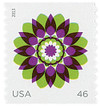
# 4723 - 2013 46c Kaleidoscope Flowers: Green and Purple
U.S. # 4723
2013 46¢ Yellow-Green
Kaleidoscope Flowers
A popular children’s toy today, the kaleidoscope began as a tool for artists and was widely enjoyed by adults as a leisure activity. In the early 1800s, scientists began experimenting with light and optics. “Philosophical toys” appeared, both entertaining and sharing scientific advances.
One of these new philosophical toys was the kaleidoscope, invented by Scotsman Dr. David Brewster in 1816. The name comes from the Greek words kalos eidos scopos, which means “beautiful form watcher.” The arrangement of mirrors and brightly colored objects in a tube created limitless beautiful patterns that Brewster thought could serve as inspiration for designers and artists.
American Charles Bush vastly improved on the kaleidoscope in 1873, patenting new features including a stand and rotating wheel to increase the number of designs. He also introduced the use of ampules, small glass vials filled with liquids of different densities, which allowed for more intricate designs.
The kaleidoscope lost popularity among adults as new technologies emerged. However, a 1985 exhibit of over 100 kaleidoscopes brought renewed interest. The Brewster Kaleidoscope Society was soon formed, bringing together both collectors and artists, and encouraging new advancements in kaleidoscope design.
Art director Antonio Alcalá designed the Kaleidoscope Flower stamps using the art of graphic artists Petra and Nicole Kapitza. Each stamp pictures the same flower shape with different colors, creating the illusion that the patterns recede or move forward.
Value: 46¢ first class letter rate
Issued: January 14, 2013
First Day City: Kansas City, MO
Type of Stamp: Definitive
Printed by: Banknote Corporation of America for Sennett Security Products
Method: Offset printing in coils of 3,000 and 10,000
Perforation: Serpentine Die Cut 11
Self-Adhesive
Quantity Printed: 42,500,000 stamps
The Kaleidoscope Flower stamps continue the U.S.P.S. tradition of picturing beautiful flowers on postage. These stamps were issued in large coils for use by businesses that send large amounts of first-class letters.
U.S. # 4723
2013 46¢ Yellow-Green
Kaleidoscope Flowers
A popular children’s toy today, the kaleidoscope began as a tool for artists and was widely enjoyed by adults as a leisure activity. In the early 1800s, scientists began experimenting with light and optics. “Philosophical toys” appeared, both entertaining and sharing scientific advances.
One of these new philosophical toys was the kaleidoscope, invented by Scotsman Dr. David Brewster in 1816. The name comes from the Greek words kalos eidos scopos, which means “beautiful form watcher.” The arrangement of mirrors and brightly colored objects in a tube created limitless beautiful patterns that Brewster thought could serve as inspiration for designers and artists.
American Charles Bush vastly improved on the kaleidoscope in 1873, patenting new features including a stand and rotating wheel to increase the number of designs. He also introduced the use of ampules, small glass vials filled with liquids of different densities, which allowed for more intricate designs.
The kaleidoscope lost popularity among adults as new technologies emerged. However, a 1985 exhibit of over 100 kaleidoscopes brought renewed interest. The Brewster Kaleidoscope Society was soon formed, bringing together both collectors and artists, and encouraging new advancements in kaleidoscope design.
Art director Antonio Alcalá designed the Kaleidoscope Flower stamps using the art of graphic artists Petra and Nicole Kapitza. Each stamp pictures the same flower shape with different colors, creating the illusion that the patterns recede or move forward.
Value: 46¢ first class letter rate
Issued: January 14, 2013
First Day City: Kansas City, MO
Type of Stamp: Definitive
Printed by: Banknote Corporation of America for Sennett Security Products
Method: Offset printing in coils of 3,000 and 10,000
Perforation: Serpentine Die Cut 11
Self-Adhesive
Quantity Printed: 42,500,000 stamps
The Kaleidoscope Flower stamps continue the U.S.P.S. tradition of picturing beautiful flowers on postage. These stamps were issued in large coils for use by businesses that send large amounts of first-class letters.









